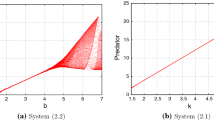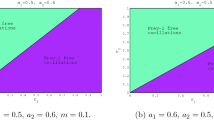Abstract
A recent field manipulation on a terrestrial vertebrate showed that the fear of predators alone altered anti-predator defences to such an extent that it greatly reduced the reproduction of prey. Because fear can evidently affect the populations of terrestrial vertebrates, we proposed a predator–prey model incorporating the cost of fear into prey reproduction. Our mathematical analyses show that high levels of fear (or equivalently strong anti-predator responses) can stabilize the predator–prey system by excluding the existence of periodic solutions. However, relatively low levels of fear can induce multiple limit cycles via subcritical Hopf bifurcations, leading to a bi-stability phenomenon. Compared to classic predator–prey models which ignore the cost of fear where Hopf bifurcations are typically supercritical, Hopf bifurcations in our model can be both supercritical and subcritical by choosing different sets of parameters. We conducted numerical simulations to explore the relationships between fear effects and other biologically related parameters (e.g. birth/death rate of adult prey), which further demonstrate the impact that fear can have in predator–prey interactions. For example, we found that under the conditions of a Hopf bifurcation, an increase in the level of fear may alter the direction of Hopf bifurcation from supercritical to subcritical when the birth rate of prey increases accordingly. Our simulations also show that the prey is less sensitive in perceiving predation risk with increasing birth rate of prey or increasing death rate of predators, but demonstrate that animals will mount stronger anti-predator defences as the attack rate of predators increases.














Similar content being viewed by others
References
Beddington JR (1975) Mutual interference between parasites or predators and its effect on searching efficiency. J Anim Ecol 44(1):331–340
Cantrell RS, Cosner C (2001) On the dynamics of predator–prey models with the Beddington–DeAngelis functional response. J Math Anal Appl 257(1):206–222
Castillo-Chavez C, Thieme HR (1995) Asymptotically autonomous epidemic models. Math Popul Dyn Anal Heterog 1:33–50
Clinchy M, Sheriff MJ, Zanette LY (2013) Predator-induced stress and the ecology of fear. Funct Ecol 27(1):56–65
Creel S, Christianson D (2008) Relationships between direct predation and risk effects. Trends Ecol Evolut 23(4):194–201
Creel S, Christianson D, Liley S, Winnie JA (2007) Predation risk affects reproductive physiology and demography of elk. Science 315(5814):960–960
Cresswell W (2011) Predation in bird populations. J Ornithol 152(1):251–263
DeAngelis DL, Goldstein RA, O’Neill RV (1975) A model for tropic interaction. Ecology 56(4):881–892
Dhooge A, Govaerts W, Kuznetsov YA (2003) Matcont: a matlab package for numerical bifurcation analysis of ODEs. ACM Trans Math Softw (TOMS) 29(2):141–164
Dhooge A, Govaerts W, Kuznetsov YA, Meijer HGE, Sautois B (2008) New features of the software matcont for bifurcation analysis of dynamical systems. Math Comput Model Dyn Syst 14(2):147–175
Eggers S, Griesser M, Ekman J (2005) Predator-induced plasticity in nest visitation rates in the Siberian jay (Perisoreus infaustus). Behav Ecol 16(1):309–315
Eggers S, Griesser M, Nystrand M, Ekman J (2006) Predation risk induces changes in nest-site selection and clutch size in the Siberian jay. Proc R Soc B Biol Sci 273(1587):701–706
Fontaine JJ, Martin TE (2006) Parent birds assess nest predation risk and adjust their reproductive strategies. Ecol Lett 9(4):428–434
Freedman HI, Wolkowicz GSK (1986) Predator–prey systems with group defence: the paradox of enrichment revisited. Bull Math Biol 48(5/6):493–508
Ghalambor CK, Peluc SI, Martin TE (2013) Plasticity of parental care under the risk of predation: how much should parents reduce care? Biol Lett 9(4):20130154
Gilpin ME, Rosenzweig ML (1972) Enriched predator–prey systems: theoretical stability. Science 177(4052):902–904
Holling CS (1965) The functional response of predators to prey density and its role in mimicry and population regulation. Mem Entomol Soc Can 97(S45):5–60
Hua F, Fletcher RJ, Sieving KE, Dorazio RM (2013) Too risky to settle: avian community structure changes in response to perceived predation risk on adults and offspring. Proceedings of the Royal Society B: Biological Sciences 280(1764):20130762
Hua F, Sieving KE, Fletcher RJ, Wright CA (2014) Increased perception of predation risk to adults and offspring alters avian reproductive strategy and performance. Behav Ecol 25(3):509–519
Huang J, Ruan S, Song J (2014) Bifurcations in a predator–prey system of Leslie type with generalized Holling type III functional response. J Differ Equ 257(6):1721–1752
Hwang TW (2003) Global analysis of the predator–prey system with Beddington–DeAngelis functional response. J Math Anal Appl 281(1):395–401
Hwang TW (2004) Uniqueness of limit cycles of the predator–prey system with Beddington–DeAngelis functional response. J Math Anal Appl 290(1):113–122
Ibáñez-Álamo JD, Soler M (2012) Predator-induced female behaviour in the absence of male incubation feeding: an experimental study. Behav Ecol Sociobiol 66(7):1067–1073
Kooij RE, Zegeling A (1997) Qualitative properties of two-dimensional predator–prey systems. Nonlinear Anal Theory Methods Appl 29(6):693–715
Kuang Y, Freedman HI (1988) Uniqueness of limit cycles in Gause-type models of predator–prey systems. Math Biosci 88(1):67–84
Lima SL (1998) Nonlethal effects in the ecology of predator–prey interactions. Bioscience 48(1):25–34
Lima SL (2009) Predators and the breeding bird: behavioural and reproductive flexibility under the risk of predation. Biol Rev 84(3):485–513
May RM (1972) Limit cycles in predator–prey communities. Science 177(4052):900–902
McAllister CD, LeBrasseur RJ, Parsons TR, Rosenzweig ML (1972) Stability of enriched aquatic ecosystems. Science 175(4021):562–565
Meiss JD (2007) Differential dynamical systems, vol 14. SIAM, Philadelphia
Orrock JL, Fletcher RJ (2014) An island-wide predator manipulation reveals immediate and long-lasting matching of risk by prey. Proc R Soc B Biol Sci 281(1784):20140391
Peacor SD, Peckarsky BL, Trussell GC, Vonesh JR (2013) Costs of predator-induced phenotypic plasticity: a graphical model for predicting the contribution of nonconsumptive and consumptive effects of predators on prey. Oecologia 171(1):1–10
Perko L (1996) Differential equations and dynamical systems. Springer, New York
Pettorelli N, Coulson T, Durant SM, Gaillard JM (2011) Predation, individual variability and vertebrate population dynamics. Oecologia 167(2):305–314
Preisser EL, Bolnick DI (2008) The many faces of fear: comparing the pathways and impacts of nonconsumptive predator effects on prey populations. PloS One 3(6):e2465
Riebesell JF (1974) Paradox of enrichment in competitive systems. Ecology 55(1):183–187
Rosenzweig ML (1971) Paradox of enrichment: destabilization of exploitation ecosystems in ecological time. Science 171(3969):385–387
Ruan S, Xiao D (2001) Global analysis in a predator-prey system with nonmonotonic functional response. SIAM J Appl Math 61(4):1445–1472
Seo G, DeAngelis DL (2011) A predator–prey model with a Holling type I functional response including a predator mutual interference. J Nonlinear Sci 21(6):811–833
Sheriff MJ, Krebs CJ, Boonstra R (2009) The sensitive hare: sublethal effects of predator stress on reproduction in snowshoe hares. J Anim Ecol 78(6):1249–1258
Song Y, Zou X (2014) Bifurcation analysis of a diffusive ratio-dependent predator prey model. Nonlinear Dyn 78(1):49–70
Song Y, Zou X (2014) Spatiotemporal dynamics in a diffusive ratio-dependent predator prey model near a Hopf–Turing bifurcation point. Comput Math Appl 67(10):1978–1997
Sugie J, Kohno R, Miyazaki R (1997) On a predator–prey system of Holling type. Proc Am Math Soc 125(7):2041–2050
Svennungsen TO, Holen ØH, Leimar O (2011) Inducible defenses: continuous reaction norms or threshold traits? Am Nat 178(3):397–410
Wirsing AJ, Ripple WJ (2011) A comparison of shark and wolf research reveals similar behavioural responses by prey. Front Ecol Environ 9(6):335–341
Wolkowicz GSK (1988) Bifurcation analysis of a predator-prey system involving group defence. SIAM J Appl Math 48(3):592–606
Zanette LY, White AF, Allen MC, Clinchy M (2011) Perceived predation risk reduces the number of offspring songbirds produce per year. Science 334(6061):1398–1401
Zhu H, Campbell SA, Wolkowicz GSK (2003) Bifurcation analysis of a predator–prey system with nonmonotonic functional response. SIAM J Appl Math 63(2):636–682
Author information
Authors and Affiliations
Corresponding author
Additional information
Research partially supported by the Natural Sciences and Engineering Research Council of Canada.
Rights and permissions
About this article
Cite this article
Wang, X., Zanette, L. & Zou, X. Modelling the fear effect in predator–prey interactions. J. Math. Biol. 73, 1179–1204 (2016). https://doi.org/10.1007/s00285-016-0989-1
Received:
Revised:
Published:
Issue Date:
DOI: https://doi.org/10.1007/s00285-016-0989-1




